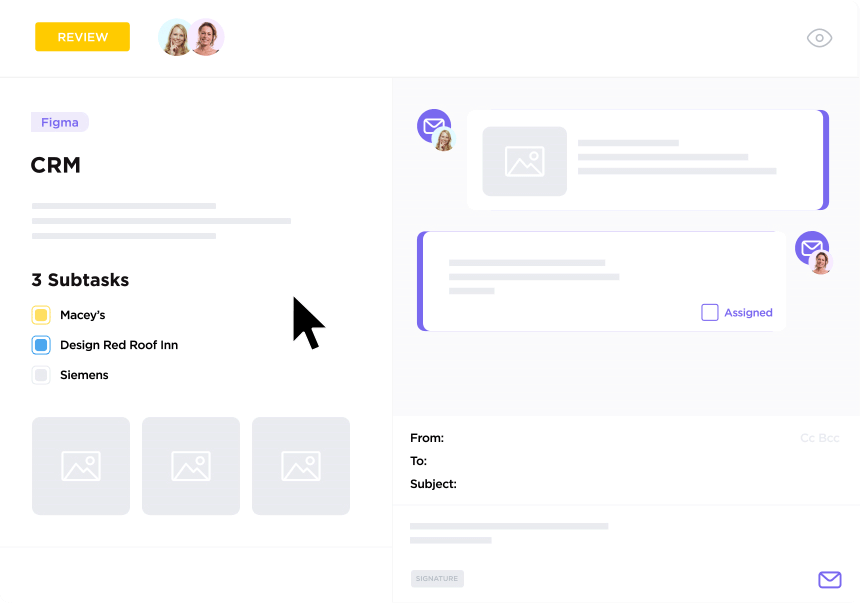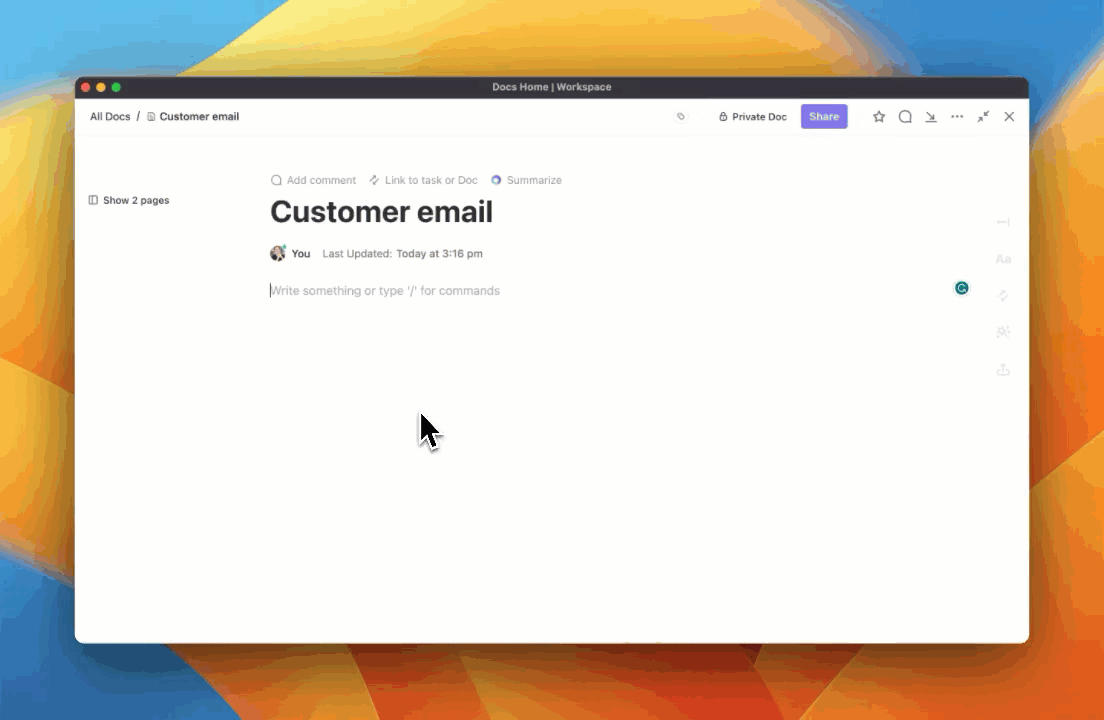10 Effective Email Management Strategies to Boost Productivity

Sorry, there were no results found for “”
Sorry, there were no results found for “”
Sorry, there were no results found for “”

Imagine your daily routine at work. What’s the first thing you do when you start your work day? In all likelihood, your day starts with checking emails. In fact, it may be a recurring feature, given that professionals check their emails around 15 times daily!
Are your email notifications going off, and you have so many emails in your inbox that you don’t know where to start? You’re in the right place for email management tips.
The situation can get so bad that you may even suffer from email anxiety (no, we didn’t make that up!). It is a legitimate condition marked by the feeling of overwhelming fear and anxiety that affects productivity and leaves a dent in your mental health.
Thankfully, we have the top 10 email management strategies to prevent you from spiraling into such a state.
The problem is very evident—your inbox is overflowing with emails. Before suggesting a solution, we need to look at the underlying problem. Following are some of the reasons behind a cluttered email inbox:
Handling emails will get easier with the right email productivity tools and complementary email management strategies. Here are 10 ways to make the best of them:
Full inboxes waste 27 minutes daily, and even that’s an ambitious estimate. You have to manually go through the emails (or at least their subject lines), decide whether they are useful, and organize the emails by priority, sender, etc.
You’ll have to be super-focused (and superhuman) to get all this done in the said 27 minutes!
On the other hand, effective email management software solutions like the one offered by ClickUp, will do all of this for you. Email management tools revolutionize inbox organization. Use it to sort emails by priority, snooze notifications, and intelligently categorize emails to manage the incoming stream expertly.
Plus, when using ClickUp for email management, you don’t have to switch to an unfamiliar interface. You get the same ease and convenience as the standard layout offered by established email service providers.
So, harness such email automation to focus on things that genuinely deserve your attention.
On average, individuals check their emails every 37 minutes or 15 times a day. Doing so interrupts productivity and wastes approximately an additional 21 minutes per day than what would have been spent during hourly email checks.
Even hourly checks dampen productivity somewhat, as you would be dealing with Task A while worrying about Task B, which you just received! Experts recommend checking your emails at most three times a day.
First, prepare your schedule when you start your day in the morning. Second, in the afternoon, after your lunch break, address any pressing matters and follow up. Finally, before the end of the workday—you respond to the day’s communications and create an agenda for the following day.
Following such a routine eliminates distraction, maintains productivity, and offers peace of mind.
📮ClickUp Insight: Nearly 42% of knowledge workers prefer email for team communication. But it comes at a cost. Since most emails only reach select teammates, knowledge stays fragmented, hampering collaboration and quick decisions. To improve visibility and accelerate collaboration, leverage an everything app for work like ClickUp, which turns your emails into actionable tasks within seconds!
Most email service providers offer standard tabs to help users organize their inboxes. For instance, typical emails end up in the primary tab or the main inbox by default, while marketing emails trickle into the promotions tab, and the social tab contains notifications from social media in Gmail. The rest go to the spam folder.
Additionally, users get organizational tools like labels, folders, and categories to streamline it further. Follow a functional or role-based approach while creating folders to sort your email and navigate through it easily. For example, say you’re a project manager building a website.
For the inbox for email project management—create separate folders dedicated to developers, design teams, test and deployment, and clients. Then, depending on the project priority and stage of development, check the appropriate folder that matters first.
Since we’re on email organization and categorization, let’s discuss rule-based filters.
Rule-based filters are a quick email automation hack to sort messages. They evaluate incoming emails based on predefined criteria like the sender’s email address, subject lines, and specific keywords.
Then, based on these conditions, they trigger automatic actions, such as applying labels, moving to folders, highlighting text, and even deleting emails.
For instance, you set up a rule-based filter for the critical clients’ names. Emails related to this topic, both internal and external, will be effectively labeled and moved to a designated folder for easy access.
On the other hand, you can dump promotional emails in another folder using another rule-based filter. In this manner, you’ll reduce the visual clutter in the primary inbox while gaining full visibility of the emails that matter.
Plus, as professionals waste about 11 minutes daily manually sorting emails, you’ll also save time and effort.
Deleting unnecessary emails is a proactive email management strategy for achieving a decluttered, streamlined, and organized inbox.
Removing all the unwanted, irrelevant, and outdated messages not only prevents hoarding but is also very cathartic. It gives you control over the influx of emails and helps you feel less overwhelmed.
The visual clarity also saves you the cognitive load and frustration of sifting through unimportant emails and making messages searchable.
The same philosophy applies to unsubscribing from newsletters and email marketing campaigns. Use the unsubscribe link if a promotional email or newsletter sits unread in your inbox for over two weeks.
Don’t know if an email is worthy of retention or deserves deletion? Follow the OHIO (Only Hande It Once) model to decide. This single-touch litmus test relies on first impressions to make intuitive decisions on whether the email offers any value. As such, you’re spared the agony of constantly deliberating whether an email is ‘worth it.’
Plus, the email can sit in the trash for 30 days as a safety net. You can recover it if needed— and if it auto-deletes, you never needed it anyway! You can also use the archive folder to put away all the emails you’ve already read.
As emails become more ubiquitous, it is much easier to correspond through them. However, if you’re prone to sending too many emails, especially for minor things, prepare to receive the same treatment. Email also gives rise to long, convoluted threads of written exchanges, which easily get out of hand.
Conversely, reducing the volume of outgoing emails minimizes the stream of incoming replies and responses. You’ll be doing your inbox a favor and contributing to a more focused, organized digital workspace that hinges on front-loading value.
Switching to email alternatives like instant messaging, project management tools, or even phone calls will prioritize concise and clear communication. You’ll no longer be compelled to draft lengthy emails with salutations and discourses and get straight to the meat of the update and discussion.
With such a positive, intentional, and meaningful communication culture, you’ll save time and effort and get more done in less.

Do you often repeatedly write and send the same (or similar) emails? If yes, then it’s time for you to switch over to email templates and canned responses instead.
You don’t have to be a master wordsmith to draft canned responses to common messages and queries. After all, you don’t have to write emails from scratch! Simply select an email writing tool and feed it the right prompts, and you’ll get several options for canned responses in seconds!

Apart from making this task easier and less time-consuming, these tools ensure branding consistency and error reduction while maintaining high response rates.
Tools like ClickUp AI lend almost infinite scalability to businesses as you can intelligently generate personalized responses to high volumes of similar messages and inquiries.
fClickUp AI offers flexibility in crafting emails for specific use cases and applications, content marketing, event planning, survey writing, and more. Use it to make emails clearer, more concise, and well-formatted.
Email management strategies and effective time management go hand in hand. We’ve already illustrated how poor inbox management drains time and resources. Conversely, having very little time makes it tougher to handle emails efficiently.
The two-minute rule perfectly balances time and organization to mitigate procrastination. According to this principle, if you require less than two minutes to complete a task, respond immediately rather than postpone it.
In the case of email management, the two-minute rule helps maintain an organized and clutter-free inbox while staying responsive.
Use the two-minute rule to respond, delegate, delete, or act upon an email. Say, if the email requires a quick acknowledgment or a brief answer or is tied to a simple task you can complete immediately, then addressing them instantly will prevent backlogs.
Do note that the two-minute rule is only a productivity hack that needs to be applied judiciously on a case-to-case basis. You can only evaluate some emails by the same parameters, as some may involve a nuanced approach.
So, use the quick fix for smaller emails while categorizing and scheduling activities for the more complex ones.
Shared inboxes are inbox management tools for centralizing emails and associated data. It is a repository of all incoming and outgoing emails that combines multiple inboxes for teams and departments to collaborate.
Such a unified platform with proper access control streamlines data and knowledge sharing without the explicit need to exchange emails.
If you’ve ever been CCed in email chains to stay informed, you’ll understand the annoyance of constant (sometimes unwanted) notifications!
Shared inboxes are a boon for customer-facing operations such as marketing, sales, and support, as managers can quickly and efficiently assign emails to team members.
Doing so ensures that everything runs smoothly and that your business can respond to inquiries with maximum expertise and minimum time.
Platforms like ClickUp take shared inboxes ahead with tools like ClickUp Docs. It is a common workspace where team members create, share, and collaborate on rich documents, wikis, and knowledge bases.
Plus, you can connect these to workflows for automation, edit documents in real-time, leave comments, assign tasks, and do much more than being stuck drafting emails!
Integration and system consolidation is the last of our email management strategies. They help set up a level-playing field by patching the entire company’s tech stack.
The bridging of disparate systems and platforms eases data and information flow while cementing any gaps, eliminating bottlenecks, and providing a uniform digital environment. It also prevents the formation of data siloes and has a complementary effect on various business activities.

For example, integrating email with calendar and video conferencing applications lets you set up alerts for meeting invites and join them immediately.
Similarly, email integration with customer relationship management (CRM) platforms grants access to relevant customer information to deliver personalization without switching platforms.
Fortunately, ClickUp integrations span over 1000+ tools to operate natively with various CRM platforms, cloud storage options, calendar applications, productivity tools, and more.
In short, integrating your Gmail and Outlook inbox with ClickUp is truly a match made in heaven.
That’s a wrap on our top 10 strategies for email management.
While the above tips can help—mastering the art of effective email management is not a static skill.
It involves a transformative approach where you must constantly innovate and improve to gain finer control over your inbox.
Moreover, instead of focusing on taming your inbox, aspire to develop a communication system that prioritizes efficiency, organization, and frictionless exchanges. Such a framework will push emails (or any other form of communication, for that matter) as a catalyst and enabler of productivity and meaningful work.
© 2025 ClickUp